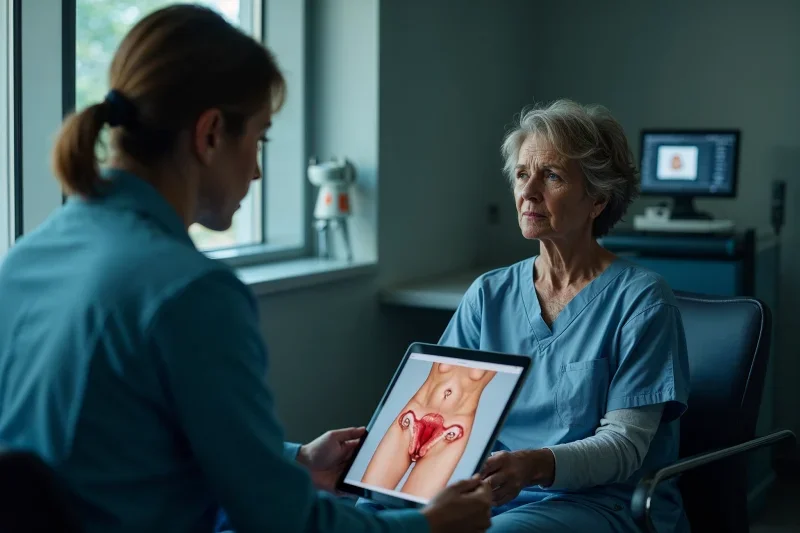What is the Recovery Time for a Robotic Hysterectomy in Burleson, T
Categories:
By: Ethan Cole
Thinking about scheduling a robotic hysterectomy in Burleson, TX—or anywhere in the wider Dallas-Fort Worth area? If so, recovery time is likely your first concern. The good news is that patients who undergo minimally invasive robotic-assisted laparoscopic hysterectomy surgery with experienced robotic surgeons like Dr. Jason Neef at North Texas Surgical Specialists often go home the same day and resume desk-based work in just 2-3 weeks. That quick turnaround, compared to 6-8 weeks after traditional open surgery, is one reason robotic surgery is changing women’s health across Texas.
Below, we’ll unpack why the robotic system, smaller incisions, and surgeon-controlled robotic arms speed healing, explain the advantages over conventional laparoscopic surgery and open surgeries, and share insider tips for a smoother recovery process.
Key Takeaways
Robotic hysterectomy recovery times average 2-4 weeks for daily tasks; strenuous activity and sexual intercourse generally wait until week six.
Tiny 8-12 mm incisions mean less pain, less blood loss, and shorter hospital stays—often just hours.
Good nutrition, gentle movement, and following medicine instructions precisely can shave days off healing.
Compared to open abdominal hysterectomy, minimally invasive robotic techniques reduce infection risk, improving overall outcomes in the Dallas-Fort Worth medical community.
Why Robotic-Assisted Hysterectomy Is Considered a Game-Changer
Robotic Technology 101
“Robotic” doesn’t mean a machine performs surgery alone. Instead, an experienced robotic surgeon sits at a console and utilizes a computerized robotic arm controlled in real time. The system translates each hand movement into micro-motions of wristed surgical tools inside your abdomen. A high-definition 3-D camera provides a better view than the naked eye, giving the surgeon unparalleled precision and control.
Benefits of a Robotic Hysterectomy
Smaller incisions: 3-5 dime-sized cuts instead of a 6-inch open incision.
Less blood loss and less pain because tissues are handled delicately.
Faster recovery time: patients go home the same day or the morning after.
Reduced scar tissue compared to open surgery, helpful if future pelvic surgery is required.
Quicker return to normal activities, which can be vital for busy professionals and parents around Burleson and Fort Worth.
Conditions Often Treated
Robotic-assisted laparoscopic hysterectomy may be recommended for uterine fibroids, abnormal bleeding, adenomyosis, endometriosis, prolapse, or early-stage cancer. When medicine fails, removing the uterus robotically offers definitive relief with fewer side effects.
Typical Recovery Timeline After Robotic Laparoscopic Hysterectomy
Although minimally invasive surgery means faster recovery, hysterectomy is still major surgery. Knowing what to expect day-by-day helps you plan child-care, work leave, and support at home.
|
Phase |
Time Frame |
How You Might Feel |
Allowed Activities |
Red Flags |
|
Immediate |
Day 0 |
Drowsy, shoulder gas pain, mild cramping |
Short walks to bathroom, sipping water |
Severe nausea, heavy bleeding |
|
Early Home |
Days 1-7 |
Fatigue, incision tenderness |
Showering, 5-minute strolls, light meals |
Fever > 100.4°F, calf pain |
|
Building Strength |
Weeks 2-3 |
Energy surge, fewer pain pills |
Desk work, driving locally, light household chores |
Worsening cramps, foul discharge |
|
Momentum |
Weeks 4-5 |
80-90 % back |
Light gym, lifting <10 lbs |
New bleeding, hernia bulge |
|
Full Return |
Weeks 6-8 |
Nearly normal |
Sex, swimming, heavy workouts |
Persistent pelvic pain |
First 24 Hours
Most Burleson patients wake up with four or five small bandages and little need for narcotics. Robotic surgery often allows discharge the same evening, aided by anti-nausea medicine to keep you comfortable on the drive home.
Week 1: Gentle Motion
Minimally invasive robotic surgery gives you permission to move earlier:
Walk around the living room every two hours.
Practice diaphragmatic breathing to prevent lung congestion.
Eat protein-rich foods and take a stool softener to protect the incision from straining.
Weeks 2-4: Back to Work
Thanks to smaller incisions and less tissue trauma, many women with desk jobs in the Dallas-Fort Worth corridor return to the office after just 14 days. If your role involves prolonged standing—say, teaching or retail—talk with your employer about shorter shifts until week four.
Weeks 5-8: Full Activity
Your internal stitches are now strong enough for core workouts, lifting kids, or resuming sexual activity. Always confirm with your gynecologic surgeon before an intense spin class or marathon training.
Factors That Influence Recovery Times
Type of Surgery
Total hysterectomy (uterus + cervix) heals faster than a radical hysterectomy that removes more tissue.Patient Health
Nonsmokers with a healthy BMI heal more quickly. Diabetes or hypertension can slow wound closure.Surgical Expertise
A high-volume, fellowship-trained robotic surgeon like Dr. Jason Neef can complete procedures faster, reducing anesthesia time.Support System
Having groceries pre-stocked and someone to drive kids to school minimizes stress, which research shows can delay healing.
Tips for Speeding Up Recovery Safely
Follow discharge instructions: take pain medicine before pain escalates; skipping doses prolongs discomfort.
Hydrate: eight glasses of water thin mucus, preventing coughing fits that strain stitches.
Embrace protein: chicken, Greek yogurt, and beans repair muscle fibers cut during invasive surgery.
Avoid heavy lifting: anything over a gallon of milk before week four jeopardizes the sutures.
Monitor incisions: any swelling larger than a quarter or pus-like drainage needs an urgent call to your care team.
Choosing a Robotic Surgical Team in Burleson
The surgeon’s skill set is as critical as the robotic tools. Dr. Jason Neef and the team at North Texas Surgical Specialists have advanced training in robotic techniques and have performed hundreds of robotic hysterectomies. During your consultation, ask:
How many robotic-assisted surgeries do you perform monthly?
What is your conversion rate to traditional open surgery?
Who fields after-hours questions?
Surgery can be done in multiple hospitals across the region, but high-volume centers usually offer shorter hospital stays and robust post-op support.
The Bottom Line
A robotic hysterectomy is considered a highly effective, minimally invasive surgical option that replaces an abdominal hysterectomy for many women. When performed by an experienced robotic surgeon, the procedure offers smaller incisions, less pain, and quicker recovery—often allowing Dallas-Fort Worth patients to return to busy lives within a month. If you’re weighing the benefits of robotic versus conventional laparoscopic surgery or open surgery, schedule an appointment with us today to discuss how the da Vinci robotic system can improve your outcome.
Schedule your robotic hysterectomy consultation today.
Call (817) 568-8731Categories:
Frequently Asked Questions
-
Insurance plans generally cover hysterectomy regardless of technique. While robotic tools add OR expenses, shorter hospital stays and quicker recovery usually offset costs, and most patients see no extra out-of-pocket fees beyond standard deductibles.
-
Robotic systems undergo rigorous safety checks. If an instrument fails, the surgeon can switch to backup tools instantly or convert to laparoscopic surgery without compromising safety, ensuring uninterrupted care.
-
Yes. Minimally invasive robotic instruments work well in higher-BMI patients, often avoiding the larger incisions required by open surgeries and decreasing wound-healing complications linked to obesity.
-
Patients may use stairs slowly the first day, holding the railing and avoiding heavy loads. Make only necessary trips until day five, then increase frequency as tolerated without pain.
-
If your cervix is removed, routine cervical screening is no longer needed unless surgery addressed cancer. However, pelvic exams remain valuable for ovarian or vaginal health; follow your gynecologist’s guidance.
-
Walking a mile spread throughout the day is fine. Any activity that raises your heart rate dramatically, such as jogging or carrying a 20-pound toddler, risks bleeding and should wait until cleared by your surgeon.
-
Yes. Removing the uterus stops menstrual bleeding permanently. If ovaries are also removed, menopause symptoms like hot flashes may appear; hormone therapy can be discussed during follow-up visits.
-
Most patients receive ibuprofen, acetaminophen, and a few opioid tablets for breakthrough pain, plus a stool softener. Antibiotics are only prescribed if infection risk factors exist or signs emerge.
-
No. Hysterectomy is the surgical removal of the uterus and is permanent. Fertility ends with the procedure, so consider family-planning goals before choosing any type of hysterectomy.
-
Your first post-op visit is usually 10-14 days after surgery to check incisions and review pathology. A six-week visit clears you for full activity. Call earlier if concerning symptoms appear.












